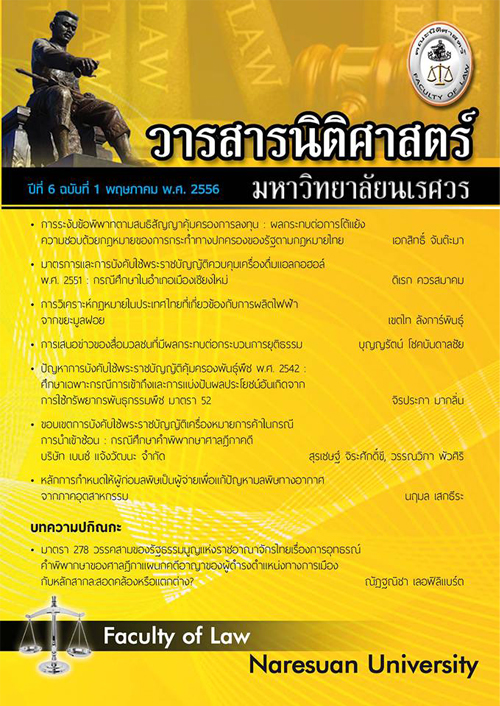The Report of Media Interfering with the Administration of Justice
Main Article Content
Abstract
There has long been accepted that trial by media is wrong and should be prevented. Publishing matter from the time somebody is arrested, up to the moment when the court finished dealing with it, the case is said to be sub judice. The medias are strictly limited to what they can report when the case is sub judice as it could prejudice a fair trial. The report of the media that interfere with the proper course of justice falls within the law of contempt. Contempt of court covers (1) report of the defendant’s previous criminal convictions, (2) report and interview that could affect witness or public (3) pictures of the accused where identity is an issue of the case. It is noted that unlike Australia, the US court usually decides the case in favor of protecting freedom of speech rather than strictly comply with sub judice doctrine. The court prefers using several remedial measures to charging the media as contempt of court. In Thailand, contempt of court is prvided in the Criminal Procedure Code section 32 (2), but the law is only applied to print media and the sub judice doctrine is not applied in Thailand as the report that could constitute the offence start from the time the case is brought to court.
Article Details
References
คณิต ณ นคร. กฎหมายอาญาภาคความผิด. พิมพ์ครั้งที่ 10. กรุงเทพฯ: วิญญูชน, 2553.
คณิต ณ นคร. กฎหมายวิธีพิจารณาความอาญา. พิมพ์ครั้งที่ 8. กรุงเทพฯ: วิญญูชน, 2555.
จรัสพิมพ์ อรรณนพพร. ความรู้ความตระหนักของสื่อมวลชนในการเสนอข่าวเกี่ยวกับอาชญากรรมและงานกระบวนการยุติธรรม, รายงานการวิจัย. นครปฐม: มหาวิทยาลัยมหิดล, 2539.
จารุลักษณ์ นุตะวานิช. “การศึกษาวิเคราะห์การใช้ภาษาในข่าวอาชญากรรมจากหนังสือพิมพ์รายวันภาษาไทย พ.ศ. 2542-2546 : คำและสำนวน.” วิทยานิพนธ์ปริญญามหาบัณฑิต สาขาวิชาภาษาไทย คณะศิลปศาสตร์ มหาวิทยาลัยธรรมศาสตร์, 2548.
ทวีเกียรติ มีนะกนิษฐ์. ประมวลกฎหมายอาญา ฉบับอ้างอิง. พิมพ์ครั้งที่ 28. กรุงเทพฯ: วิญญูชน, 2555.
ปัญญา อุดชาชน. “ความยุติธรรมกับรัฐธรรมนูญภายใต้ประชาคมอาเซียน.” วารสารนิติศาสตร์ มหาวิทยาลัยนเรศวร. 5, no.2 (พฤศจิกายน 2555): 39-79.
วรวิทย์ ฤทธิทิศ. สื่อมวลชนกับความรับผิดทางกฎหมาย. กรุงเทพฯ: วิญญูชน, 2538.
สมควร กวียะ. การสื่อสารมวลชน บทบาทหน้าที่ เสรีภาพ และความรับผิดชอบ. กรุงเทพฯ: ดอกหญ้า, 2539.
ศรีลักษณ์ ศิลปี. “ปัญหาทางด้านจริยธรรมของนักหนังสือพิมพ์ในการนำเสนอข่าวอาชญากรรม.” วิทยานิพนธ์ปริญญามหาบัณฑิต ภาควิชาการหนังสือพิมพ์ คณะนิเทศศาสตร์จุฬาลงกรณ์มหาวิทยาลัย, 2539.
ศันสนีย์ แสงโรจน์เพิ่มสุข. “อิทธิพลของพาดหัวข่าวอาชญากรรม ที่มีผลกระทบต่อผู้อ่านพาดหัวข่าวอาชญากรรมในหน้าหนึ่งหนังสือพิมพ์รายวันภาษาไทย.” วิทยานิพนธ์ปริญญามหาบัณฑิต. มหาวิทยาลัยธรรมศาสตร์ สาขาวิชาการบริหารสื่อสารมวลชน
คณะวารสารศาสตร์และสื่อสารมวลชน, 2553.
Andronos, K. "Contempt of Court." Accessed June 9, 1998. https://www.gtlaw.com.au/pubs/contemptofcourt.html.
Armstrong, M, David Lindsay and Ray Watterson. Media Law in Australia. Australia : Oxford University Press, 1996.
Australian Press Council. (1993). “Honorifics in court reports.” Australian Press Council News. 5, no.1 (1993): 2-3.
Barendt, E. “Importing United States Free Speech Jurisprudencd.” in Freedom of Communication. T. Combell and W. Sadurski (ed.). Aldershot : Dartmouth, 1994.
Brandwood, J. (2000). “You Say ‘Fair Trail’ and I Say ‘Free Press’ : British and American Approaches to Protecting Defendants’ Rights in High Profile Trials.” New York University Law Review. 75, (2000): 1412-1420.
Chesterman, M. “The Media and The Law : Prohibited Publication.” Topic 1 Free speech And The Media, Reproduce materials for Media Law : Prohibited Publication. Sydney, Asutralia : The University of New South Wales, 1998.
Chesterman, M. “OJ and the Dingo : How Media Pubicity Regulatiog to Criminal Cased Tried by Jury is Dealt with in Australia and America.” 45 American Journal of Comparative Law, (1997): 109-120.
David M. Rabban. Free Speech in Its Forgotten Years. New York : Cambridge University Press.
Edgeworth, B. and M. Newcity. “Politicians, and defamation Law and the public figure defencd.” Law in Context. 10, no.1 (1992): 39-62.
Krause, S. “Punishing the Press : Using Contempt of Court to Secure the Right to a Fair Trail.” Boston University Law Review. 76, (1996): 537-574.
Lewis, A. “A Public Right to Know about public Institutions : The First Amendment as Sword.” Supreme Court Review. (1980): 37-43.
Pearson, M. The Journalist’s Guide To Medial Law. NSW: Allen & Unwin, 1997.
Stepniak, D. “A comparative Analysis of First Amendment Rights and the Televising of Court Proceedings.” Idaho Law Review. 40, (2003): 315-317.
Walker, C. “Fundamental Rights, Fair Trials and The New Audio-Visual Sector.” The Modern Law Review. 59, (1996): 517-39.


